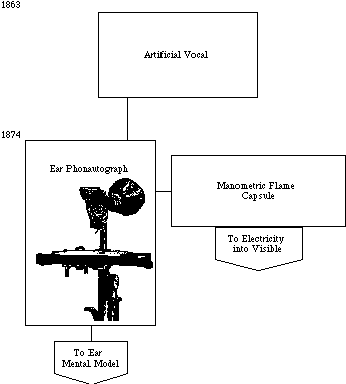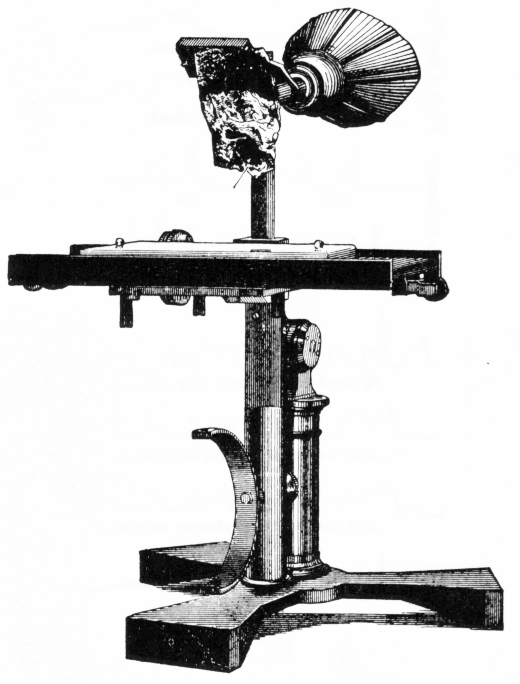







This set of linked boxes (a sub-map because it is stored 'under' a box on the main, overview map) indicates that Bell acquired extensive knowledge of how sound could be translated into mechanical motion in a way that deaf students could visualize. This expertise was unique to Bell among telegraph inventors, and explains why he regarded the transmission of speech as so important. The boxes refer to several of the devices Bell built in order to better understand the mechanics of speech. We have a scanned picture of only one to date (the 'Ear Phonautograph'). These devices remind us that Bell's knowledge was not just theoretical; it was 'hands-on'. (See 'Sound into Visible Form'). Arrows on this sub-map take you to related sub-maps.
Artificial Vocal
In 1863, Bell manufactured an artifical mouth and nasal passage and his brother Melville built the vocal chords. The inspiration was Wheatstone's version of De Kempelen's 18th century device for imitating the human voice. By squeezing air through its artificial lungs and moving its 'mouth', the apparatus was able to mimic words. Bell's father had suggested this project to help build Alexander's understanding of vocal physiology. Bell learned a great deal about how consonants and vowels are formed from this exercise, and it may also be the origin of his 'follow the analogy of nature' heuristic.See Bruce, pp. 35-7 for details.
Ear Phonautograph
At the suggestion of Clarence Black, Bell built a phonautograph using an actual human ear; sound waves coming into the eardrum were traced on smoked glass by means of a bristle brush depending from the ossicles." Once again, as with previous phonautographs, it was borne upon him that the sum or resultant of complex sound vibrations could be conveyed through a single point and expressed as an irregular wavy line. In this case, he was struck further by the way sound waves acting on a tiny membrane could move relatively heavy bones" (Bruce, p. 121).1874.See Clarence J. Blake, "The use of the Membrana Tympani as a Phonautograph and Logograph", ARCHIVES OF OPTHALMOLOGY AND OTOLOGY, VOL. 5 (1876), 1-6;____ "The Use of the Membrana Tympani as a Phonaugoraph", BOSTON MEDICAL AND SURGICAL JOURNAL, Vol. 92 (4 Feb. 1875), 121-4. Bell is mentioned in both articles as having constructed the ear phonautograph. One of his innovations was to use a glass having a curve corresponding to a circle whose radius was equal to the length of the style; this corrected for vibrations of large amplitude (see 2nd article above, p. 123).
Manometric Flame Capsule
Manometric Flame CapsuleIn the manometric flame capsule, a speaking tube and diaphragm are fastened to a gas pipe; vibrations in the diaphragm vibrate the gas, and create different patterns. Revolving mirrors can be used to enhance the effect. Like the phonautograph, the purpose here is to make speech visible. (See Bruce, 111).
Date Last Modified: Nov 11994